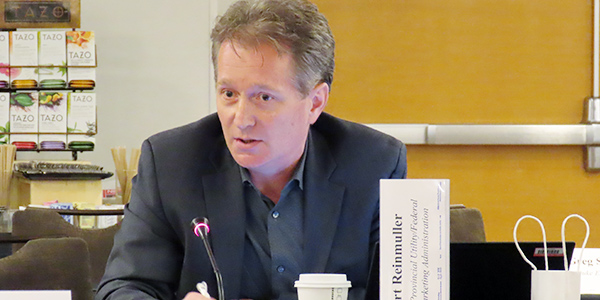ATLANTA — NERC’s Operating, Planning and Critical Infrastructure Planning committees gathered this week for their last face-to-face meetings before turning their functions over to the new Reliability and Security Technical Committee (RSTC) in June.
PC Discusses Distributed Energy White Paper
In an unusual move, the Planning Committee opened up the floor to discuss at length a draft white paper proposing to incorporate distributed energy resources such as rooftop solar panels and batteries into reliability standard TPL-001. Chair Brian Evans-Mongeon, of Utility Services Inc., said the paper initially went through the standard review process, but because of the wide-ranging implications for system planners, the leadership decided the full committee should provide comments.
“The PC doesn’t necessarily have a lot of times where they discuss topics. A lot of times we get the presentation, we ask a couple of questions and we react,” he said. “We thought that … there ought to be a little more go-around [and] discussion among PC members, observers and staff who are involved in this information.”
Committee members spent most of the discussion debating the extent to which DERs can be accounted for in system planning, a topic of growing concern for NERC. In a meeting of the System Planning Impacts from Distributed Energy Resources (SPIDER) Working Group earlier this year, Thomas Bialek of San Diego Gas & Electric warned that planners lack transparency into the energy generated by DERs, which can lead to greater risk from external disruptions. (See Rooftop PV’s ‘Hidden Loads’ Challenge Grid Planners.)
However, opinion was more divided on the wisdom of recommending changes to reliability standards, at least without gathering more information on the behavior of DERs in extreme scenarios.
“I’m really concerned about just putting it, without that detail, to a drafting team and seeing if we get lucky and they come out with something good,” said Carl Turner, engineering services director at Florida Municipal Power Agency. “Because I’ve seen drafting teams go both ways — we’ve had some that were really good, technically, and some that were not, and we got a giant mess of a standard.”
In response, Robert Reinmuller, director of transmission system planning at Hydro One Networks, pointed out that DER penetration is increasing no matter what regulators do, and that NERC may have to move with the times or be left behind.
“We have about 7,000 MW of [DER] behind the meter. … It’s coming, and it’s coming fast,” Reinmuller said. “I’m not certain that we need a standard today or tomorrow, but … we need to move toward that.”
Actions
The PC approved actions on the following reliability guidelines:
- BPS perspectives for implementing IEEE 1547-2018;
- Fuel assurance and fuel-related reliability risk analysis for the bulk power system; and
- Distributed energy resource data collection for transmission planning (authorized posting for comment).
It also approved the following white papers:
- Fast Frequency Response Fundamentals;
- IRPTF Review of NERC Reliability Standards Applicability; and
- Reliability Gaps in Reliability Standard PRC-019-2.
The Operating Committee also approved changes to the “Risks and Mitigations for Losing EMS Functions” reference document that are mainly intended to clarify vague and outdated language.
CIPC Receives GridEx Update

The GridEx Working Group plans to release its report on GridEx V by the end of March, according to Jake Schmitter, senior manager for training and exercises at NERC. Schmitter told the Critical Infrastructure Protection Committee that the group will release two versions of the report — TLP White and TLP Amber — that will both present the results of the exercise’s executive tabletop and the findings from the distributed play report. The Amber report will also include a list of participating organizations, as well as the scenario narrative.
Schmitter presented several highlights from the report, such as a geographical breakdown of participating organizations, an analysis of which participants played more realistic scenarios and the factors that allowed them to do so. He also discussed the future of the working group, which will become part of the Electricity Information Sharing and Analysis Center after the dissolution of the CIPC.
“Our [meetings] are still going to be attached to the RSTC meetings … because a lot of the RSTC members will more than likely be members of the GridEx Working Group,” Schmitter said, adding that the group is currently selecting new members and expects to finalize the roster by the end of May.
— Holden Mann




